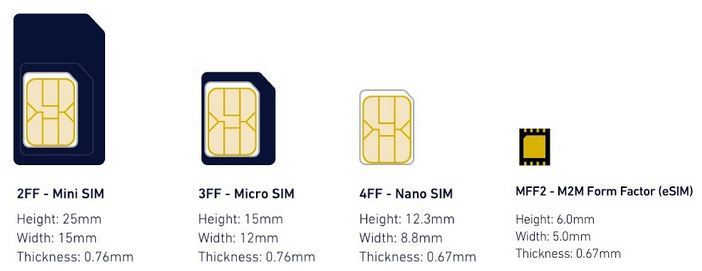State-Of-The-Art
eSIM technology provides the same functionalities as traditional SIM but it is like a programmable SIM and it is directly embedded on the hardware device. Due to very small form factor (see below), it has been designed not only for smartphones but also for the other connected equipment like smart watch or tablet and more generally speaking for the small smart objects with not enough room to host traditional SIM.

Theoretically, eSIM is bringing a lot of additional advantages and benefits (vs. traditional SIM) :
- Universal solution for smartphones but also for tablets and connected objects
- Sparing room in the devices not only smartphones (for larger battery, more powerful camera, …) but other IoT devices (watch, drone, connection module for autonomous vehicle, smart glass and smart display for virtual and augmented reality, …)
- Support for multiple configurations (one device, several subscriptions)
- Save money i.e. avoid expensive roaming through local operators
- Easy, fast (on-the-fly) and online activation of mobile subscription
- Facilitate the freedom of choice (ease the change of mobile operator)
- Reduce usage of plastics (eco-responsible)
- Secure SIM swapping (no manipulation)
Since 2016 when the Samsung Gear S2 smart watch was the first popular device to implement eSIM, analysts and researchers have been regularly predicting a huge and rapid success for the technology and massive worldwide endorsement by users. Until now, it is not the case. The usage of eSIM made progress during the last couple of years but it is still rather marginal. There are good reasons for that:
- In 2019, 10% of hardware (mainly smartphones) were equipped with eSIM card. It concerned only high-end models of few manufacturers (Google, Apple and Samsung). Beyond this small percentage, how much devices (supporting eSIM) were really exploiting the technology? Probably, much lower. In addition to that, the market of the connected objects (IoT) was mainly in a PoC and pilot phases. This means the eSIM market was not reaching its minimum critical volume to really stimulate its development.
- In June 2017, the European institutions announced the end of roaming charges in the European Union. This means eSIM was losing one important financial benefit for people travelling in Europe. So, eSIM was mainly concerning a limited category of users (people travelling in certain regions of the world).
- The experience of users with eSIM was quite painful and the service was especially disappointing. There was no real standard procedure for activation (it was depending on the operator) and it was not automatic (still need to fill manually activation information). In addition to that, the eSIM management was not integrated in the management system of the mobile operator (as for traditional SIM).
- There was also a kind of misunderstanding between the hardware manufacturers and the mobile operators. The question was related to the responsibility of whom will manage the eSIM service. It gave the impression there were battle and conflict between operators (global/virtual and local) and devices manufacturers (Google, Samsung, Apple).
But the status is currently changing due to a certain number of recent important announcements and publications since beginning of 2020:
POST Luxembourg announces the support of eSIM
POST lance l’eSIM
https://www.post.lu/particuliers/mobile/esim
Orange Luxembourg announces the support of eSIM
https://paperjam.lu/article/orange-luxembourg-lance-esim-s
Datanews predicts Proximus will support eSIM in 2020
Apple announces new generation iPhone SE equipped with eSIM
https://www.apple.com/newsroom/2020/04/iphone-se-a-powerful-new-smartphone-in-a-popular-design/
Huawei announces new P40 and P40 Pro models that are the first ones adopting eSIM
Ericsson announces Secure Entitlement server and eSIM Manager for Samsung’s Galaxy S20 and Galaxy Z Flip
Ericsson announces eSIM strategy and solution for remote provisioning of user profiles and device management
https://www.ericsson.com/en/digital-services/trending/esim
HMD ex-Nokia mobile has filed a patent for a new embedded SIM card (eSIM) solution
https://www.gsmarena.com/hmd_trademarks_new_esim_service_on_euipo_-news-41346.php
Last but not least, eSIM captured the big attention of the market researchers and analysts.
https://www.reportlinker.com/p05798536/Global-eSIM-Industry.html
They are deeply monitoring the evolution of the industry (see below)

So, the major question remains : Would all these publications be enough to create the momentum among customers and end-users in order to accelerate eSIM adoption ? If we would have a deeper look at what is happening, some elements seem to prove that we would go in this direction.
But this will be another story … 🙂
Note: This article is freely inspired from various Internet publications and discussions with experts.
